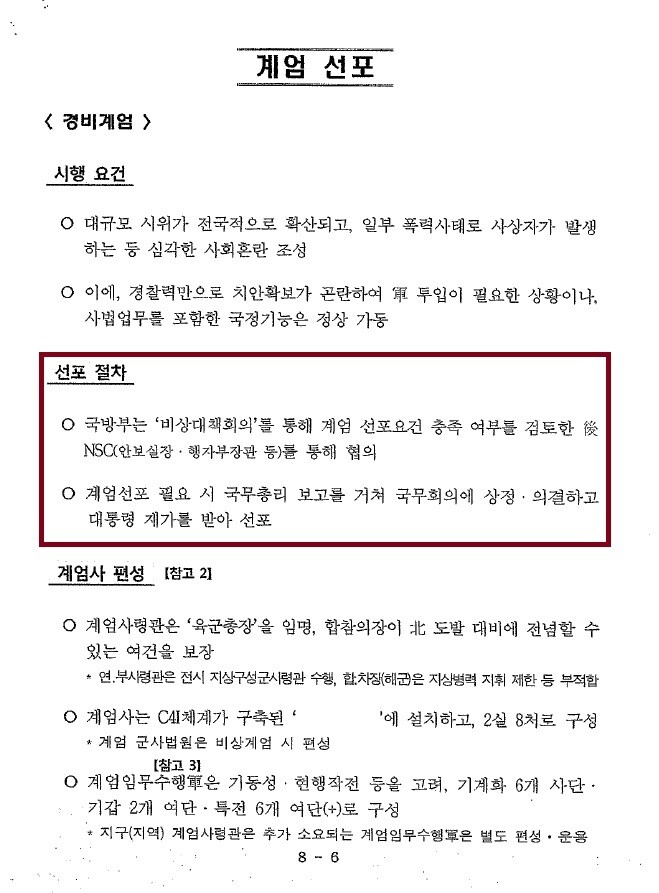hankyoreh
Links to other country sites 다른 나라 사이트 링크
Military considered martial law if constitutional court rejected Park’s impeachment in 2017

A newly released document shows that, shortly before the Constitutional Court ruled on former South Korean President’s impeachment in Mar. 2017, the South Korean army’s Defense Security Command (DSC) considered declaring martial law if demonstrators refused to accept the court rejecting the impeachment and attempted to force their way into the Blue House and the Constitutional Court.
The DSC document in question, which was made public by Democratic Party lawmaker Rep. Lee Cheol-hui on July 5, is called the “Wartime Martial Law and Joint Action Plan.” This document detailed a plan of “appointing the defense commander as the garrison commander” and “considering the option of issuing a ‘garrison order’ if a large number of protesters attempt to enter the Blue House.”
The plan was quite specific, describing a gradual intensification from security-level martial law to emergency-level martial law if the situation deteriorated and assigning three brigades to take charge of Gwanghwamun Plaza and one brigade to take charge of Yeouido. The document was submitted to then Defense Minister Han Min-goo by then DSC Commander Cho Hyun-chon.

This document was based on the prediction that the Constitutional Court would overturn Park’s impeachment. “Large groups of demonstrators who refuse to accept the results of the impeachment trial will gather in Seoul and attempt to enter and occupy the Blue House and the Constitutional Court. When the government [that is, the police] shut down large-scale demonstrations, popular emotions will ignite and sympathetic forces will rapidly gather, leading to worse violence including the throwing of fire bombs,” the DSC document said.
In recognition that it would be illegal for the Army Chief of Staff, who is not authorized to issue military commands, to order troops to be deployed in a garrison command, the DSC document proposed a way of getting around that. According to the Act on the Organization of National Armed Forces, the movement of units at the level of independent fighting brigades and above must be approved by the Minister of Defense. Despite this, the DSC document said that “It would be possible to forestall controversy by getting the approval of the Army Chief of Staff first and the Chairman of the Joint Chiefs and the Minister [of Defense] after that.”
The approach considered by the DSC was similar to how Security Commander Chun Doo-hwan deployed the army during Hanahoe’s coup on Dec. 12, 1979, and only sought the approval of Army Chief of Staff Chung Seung-hwa and President Choi Kyu-hah after the fact.
“As if illegal meddling in politics and surveillance of civilians was not enough, the Defense Security Command has hatched schemes to impose a military government. This is the end of the road for the Defense Security Command, which urgently needs to be completely overhauled,” Lee Cheol-hui said.
By Kim Tae-gyu, staff reporter
Please direct comments or questions to [english@hani.co.kr]

Editorial・opinion
![[Column] Has Korea, too, crossed the Rubicon on China? [Column] Has Korea, too, crossed the Rubicon on China?](https://flexible.img.hani.co.kr/flexible/normal/500/300/imgdb/original/2024/0419/9317135153409185.jpg) [Column] Has Korea, too, crossed the Rubicon on China?
[Column] Has Korea, too, crossed the Rubicon on China?![[Correspondent’s column] In Japan’s alliance with US, echoes of its past alliances with UK [Correspondent’s column] In Japan’s alliance with US, echoes of its past alliances with UK](https://flexible.img.hani.co.kr/flexible/normal/500/300/imgdb/original/2024/0419/2317135166563519.jpg) [Correspondent’s column] In Japan’s alliance with US, echoes of its past alliances with UK
[Correspondent’s column] In Japan’s alliance with US, echoes of its past alliances with UK- [Editorial] Does Yoon think the Korean public is wrong?
- [Editorial] As it bolsters its alliance with US, Japan must be accountable for past
- [Guest essay] Amending the Constitution is Yoon’s key to leaving office in public’s good graces
- [Editorial] 10 years on, lessons of Sewol tragedy must never be forgotten
- [Column] A death blow to Korea’s prosecutor politics
- [Correspondent’s column] The US and the end of Japanese pacifism
- [Guest essay] How Korea turned its trainee doctors into monsters
- [Guest essay] As someone who helped forge Seoul-Moscow ties, their status today troubles me
Most viewed articles
- 1[Column] The clock is ticking for Korea’s first lady
- 2Samsung barricades office as unionized workers strike for better conditions
- 3[Correspondent’s column] In Japan’s alliance with US, echoes of its past alliances with UK
- 4After 2 months of delayed, denied medical care, Koreans worry worst may be yet to come
- 5[Column] Has Korea, too, crossed the Rubicon on China?
- 6Hong Se-hwa, voice for tolerance whose memoir of exile touched a chord, dies at 76
- 7US overtakes China as Korea’s top export market, prompting trade sanction jitters
- 8All eyes on Xiaomi after it pulls off EV that Apple couldn’t
- 9[Photo] Smile ambassador, you’re on camera
- 10[News analysis] After elections, prosecutorial reform will likely make legislative agenda